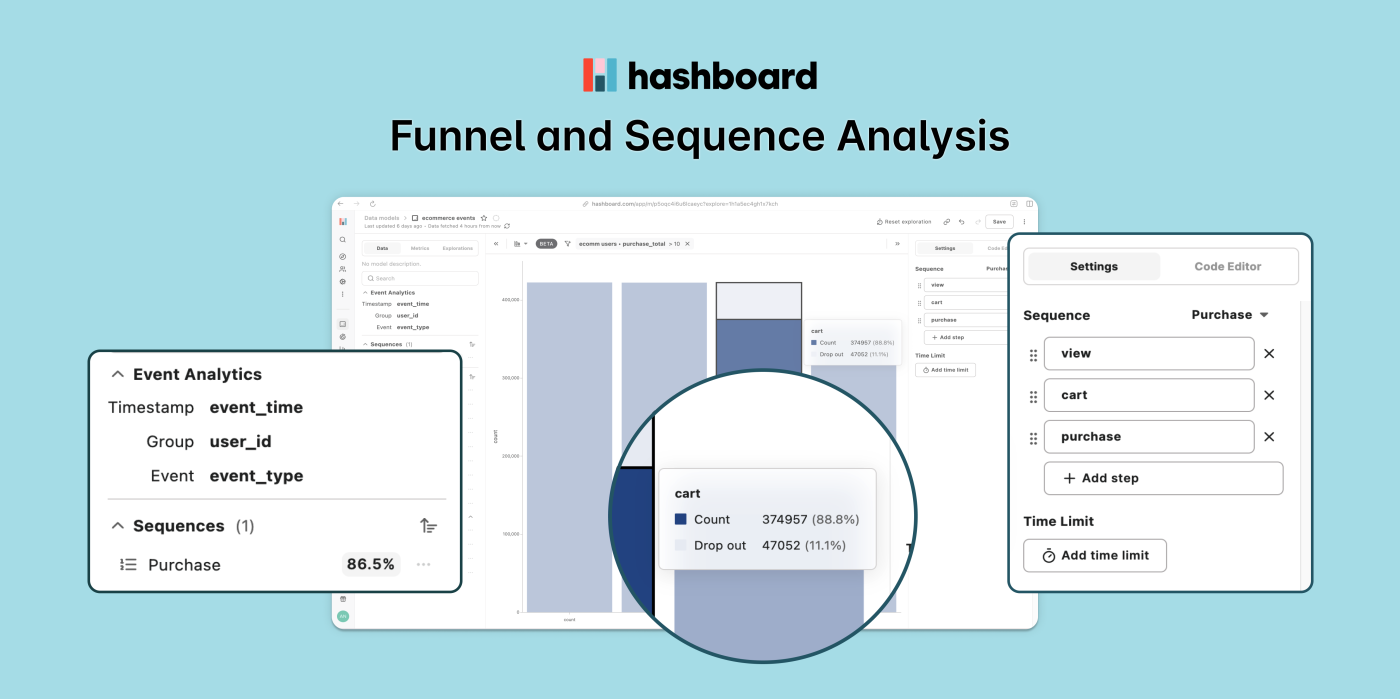Unifying Warehouse Metrics and Funnel Metrics in Hashboard


Funnels are now in GA! Check out the documentation
Today, we’re opening up Hashboard’s event analytics feature for public preview; schedule an onboarding session if you'd like to try it out. Hashboard has a free trial, so feel free to create an account and reach out to us!
The event analytics feature enables powerful funnel analytics right out of the box: you to chain together an arbitrary number of steps for user-based funnels and track retention and conversion.
Here’s how it works:
You define the type of funnel you want to analyze in your Hashboard data model: is it a funnel of users, or customers or some other resolution? You can define the core event type in the data model and also pre-define specific funnels so that they can easily be used later.
In the UI, you can select an arbitrary number of funnel steps per user. The funnel will tell you the dropoff in number of users and net retention at each step and for the overall funnel. It’s all interactive so end users can do this without writing any code.
You can also define time limits in which the funnel has to be completed and you can also add complex filters for each step in the funnel.
In the coming weeks we’re going to keep iterating on the feature and adding new functionality: we’re planning on releasing segmentation so you can split funnels by user attributes in the coming weeks. We're interested to hear if there are other features you want to see.
How we got here: background on BI tools
Business Intelligence tools can be weird: why are there so many of them? And why does the distinctions between different types of tools seem arbitrary? There are funnel-style BI tools (like MixPanel) and warehouse-oriented BI tools (like Looker and Tableau). To understand the difference between these two categories, it’s helpful to understand the underlying data architecture. And that’s a bit weird; the use case comes from the data architecture. The CFO may ask the head of data “why are we paying for Amplitude and Looker” and the head of data starts to explain the nuances of sequential analysis, SQL warehouses and event sourcing. There are certainly differences in users and nuanced differences in the analysis these two types of tools do. But my feeling is that these two tool types emerged because historically it’s been hard to do funnel analysis in SQL. And because it’s hard to do funnels in SQL it is then hard to do inside of traditional BI tools. But what if that changed?
In practice everyone wants both types of analysis in both tools:
People build retention curves and funnels in Looker (even though it’s painful and doesn’t work particularly well).
People try to build revenue reporting in MixPanel.
The event-y people are jealous that SQL BI tools can do revenue reporting and the SQL people are jealous that you can do sequential analysis in MixPanel.
Why funnels are hard to do in BI tools
BI tools usually work with column-style calculations that look like excel formulas: you sum(profit) - sum(costs). SQL is actually very bad at answering questions like “in this list of events, tell me all of the users that first saw an ad and then purchased a product”. New features in SQL warehouses like matching or older ones like window functions could technically be used to do funnels, but these end up being hard and verbose to use as well.
But, as we said, everyone has to do funnels in their BI tool. So what you end up typically doing is prepping the data to support one very specific funnel. Your data engineer creates a table called “users_and_their_activities” and there are two columns: date_saw_ad and date_bought_item. The challenge is that this is highly inflexible. What if an end user wants to explore performance of a certain campaign, and wants to see purchases of a specific product. You have to ask the data engineer to prep a new dataset.
Making funnels easy: using Hashquery to drive towards a single source of truth for metrics
Hashquery is our secret sauce and how we’re able to pull off feature launches like this. In order to serve more use cases over time, we’ve introduced a more flexible architecture for defining metrics. The SQL-oriented framework is called Hashquery and we launched an open source version of it a couple of months ago.
Hashquery is able to unify many different ways of looking at the world of analytics, and we hope that it will be a common underlying architecture that will drive end user features and give data engineers more powerful tools as well.
Hashquery is an opensource Python library that allows you to define and express complex metrics that run in your data warehouse. It compiles to SQL and does SQL-y things natively.
Metrics (and measures) and dimensions and cubing are all very natural in Hashquery (and therefore in Hashboard’s user interface)
Hashquery implements formulas and calculations and can compile them down into SQL
newIt also now implements funnels and sequential analysis and also compiles them into SQL. So it’s no longer an issue that SQL can’t do funnels.
But our goal is not just to build fun code-based tools for exploring data - but to make this useful for everyone to explore data.
Why we built funnels
Hashboard is an opinionated reporting tool. We believe that data teams should start from value, we believe that most data problems are actually curation problems, and we believe that metrics should be front and center of your workflow (check out our approach page for more of our view on data). But critical metrics like conversion and analyses like funnels have always been awkward in your BI tool.
It’s 2024 and the modern data stack has grown bloated with more tools over time and more places to look and it’s just harder to know the source of truth for metrics in your business today. We think it’s time to create a unified view of your business metrics and make them accessible to your entire organization.
The overwhelming majority of our customers either currently do funnel analysis in clunky ways or have to switch to another tool.
Historically product funnels and retention curves live in different analytics tools than the rest of your data. Today we’re bringing the two of them together into Hashboard - all of your metrics in one place.
What’s next?
We look at the data space and BI and generally see a lot that is 'obviously true' to us, but nobody else is doing. So we’re going to keep picking up those 'obviously true' features, to build the most complete view of your business. Some things that seem obviously true to the Hashboard team:
Code-based workflows should always be an option with data products… but they should also be optional.
Your BI tools should support code previews, continuous integration and continuous deployment.
Your BI tool should import all of your descriptions and metadata from your data warehouse and should have an option to instantly build from dbt and stay up to date with dbt.
Your BI tool should allow you to centrally define business metrics, KPI's and goals.
Your logic shouldn’t be trapped inside your BI tool - there should just be an easy way for engineers to pull logic out.
You shouldn’t have to go to a different tool to build user funnels.
Keep an eye on our changelog and our roadmap for more of what’s next!